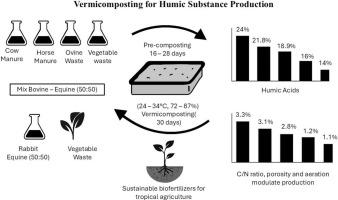Comparative evaluation of humic substance production from organic wastes in tropical vermicomposting using Eisenia foetida
Q1 Environmental Science
引用次数: 0
Abstract
The valorization of organic waste through vermicomposting has emerged as a sustainable strategy for producing humic substances, which are critical for improving soil fertility and reducing dependence on chemical fertilizers. This study compared the efficiency of humic and fulvic acid production from six organic wastes: bovine, equine, ovine, and rabbit manure, vegetable waste, and a 50:50 mixture of bovine and equine manure using Eisenia foetida under tropical conditions. All substrates underwent aerobic pre-composting (16–28 days), followed by 30 days of vermicomposting. Key parameters influencing humification included substrate porosity, aeration, and carbon/nitrogen ratios ranging from 12:1 to 50:1. Statistical analysis showed significant differences among treatments (p < 0.05). The bovine-equine mixture yielded the highest humic acid concentration (24 %), followed by equine (21.8 %) and rabbit manure (18.9 %). Ovine manure produced the highest fulvic acid content (3.3 %), while bovine and vegetable waste had the lowest yields. These findings demonstrate that substrate blending enhances microbial activity and humification efficiency. Vermicomposting provides an effective and low-cost solution to convert organic waste into humic-rich biofertilizers, supporting circular agriculture and sustainable soil management.

利用虎爱森虫堆肥从有机废物中产生腐殖质的比较评价
通过蚯蚓堆肥使有机废物增值已成为生产腐殖质物质的可持续战略,这对提高土壤肥力和减少对化肥的依赖至关重要。本研究比较了六种有机废物:牛、马、羊和兔的粪便,蔬菜废物,以及在热带条件下使用爱森尼亚的牛和马粪便的50:50混合物产生腐殖酸和黄腐酸的效率。所有基质均进行好氧预堆肥(16-28天),然后进行30天的蚯蚓堆肥。影响腐殖化的关键参数包括基质孔隙度、通气性和碳氮比(12:1 ~ 50:1)。统计学分析显示,处理间差异有统计学意义(p < 0.05)。牛马混合物腐植酸浓度最高(24%),其次是马粪(21.8%)和兔粪(18.9%)。羊粪中黄腐酸含量最高(3.3%),而牛粪和蔬菜粪中黄腐酸含量最低。这些结果表明,基质混合可以提高微生物活性和腐殖质化效率。蚯蚓堆肥提供了一种有效且低成本的解决方案,将有机废物转化为富含腐殖质的生物肥料,支持循环农业和可持续土壤管理。
本文章由计算机程序翻译,如有差异,请以英文原文为准。
求助全文
约1分钟内获得全文
求助全文
来源期刊

Bioresource Technology Reports
Environmental Science-Environmental Engineering
CiteScore
7.20
自引率
0.00%
发文量
390
审稿时长
28 days
 求助内容:
求助内容: 应助结果提醒方式:
应助结果提醒方式:


